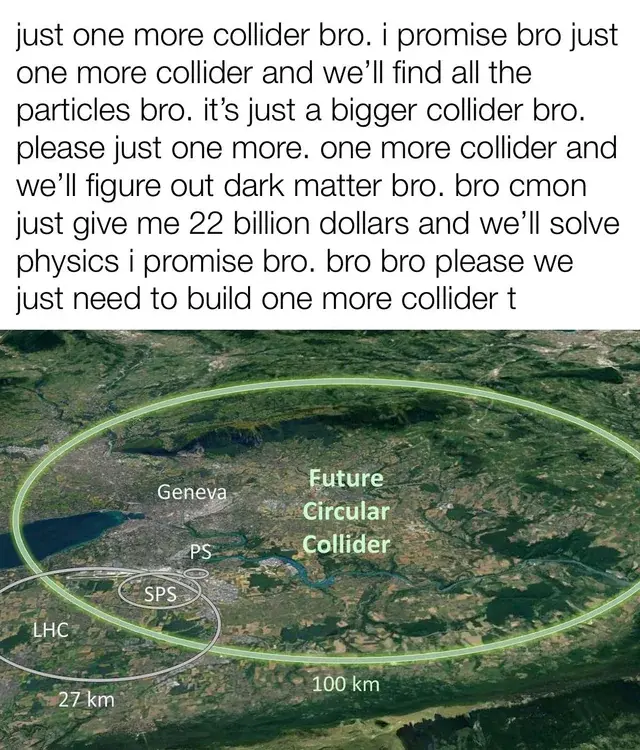this post was submitted on 08 Nov 2023
1682 points (95.3% liked)
Science Memes
11581 readers
1139 users here now
Welcome to c/science_memes @ Mander.xyz!
A place for majestic STEMLORD peacocking, as well as memes about the realities of working in a lab.

Rules
- Don't throw mud. Behave like an intellectual and remember the human.
- Keep it rooted (on topic).
- No spam.
- Infographics welcome, get schooled.
This is a science community. We use the Dawkins definition of meme.
Research Committee
Other Mander Communities
Science and Research
Biology and Life Sciences
- !abiogenesis@mander.xyz
- !animal-behavior@mander.xyz
- !anthropology@mander.xyz
- !arachnology@mander.xyz
- !balconygardening@slrpnk.net
- !biodiversity@mander.xyz
- !biology@mander.xyz
- !biophysics@mander.xyz
- !botany@mander.xyz
- !ecology@mander.xyz
- !entomology@mander.xyz
- !fermentation@mander.xyz
- !herpetology@mander.xyz
- !houseplants@mander.xyz
- !medicine@mander.xyz
- !microscopy@mander.xyz
- !mycology@mander.xyz
- !nudibranchs@mander.xyz
- !nutrition@mander.xyz
- !palaeoecology@mander.xyz
- !palaeontology@mander.xyz
- !photosynthesis@mander.xyz
- !plantid@mander.xyz
- !plants@mander.xyz
- !reptiles and amphibians@mander.xyz
Physical Sciences
- !astronomy@mander.xyz
- !chemistry@mander.xyz
- !earthscience@mander.xyz
- !geography@mander.xyz
- !geospatial@mander.xyz
- !nuclear@mander.xyz
- !physics@mander.xyz
- !quantum-computing@mander.xyz
- !spectroscopy@mander.xyz
Humanities and Social Sciences
Practical and Applied Sciences
- !exercise-and sports-science@mander.xyz
- !gardening@mander.xyz
- !self sufficiency@mander.xyz
- !soilscience@slrpnk.net
- !terrariums@mander.xyz
- !timelapse@mander.xyz
Memes
Miscellaneous
founded 2 years ago
MODERATORS
you are viewing a single comment's thread
view the rest of the comments
view the rest of the comments

I'm not seeing why the same couldn't be said for Mars, drop some mold spores and water bears down there, maybe some photosynthetic bacteria, slowly build a blanket of CO2 to warm the planet, melt/release the water from the surface, a thousand years gives a habitable planet, no asteroid steering required.
Mars is roughly a single order of magnitude larger than The Moon, in mass. The Earth is roughly 81 times the mass of The Moon. Mars doesn't have a magnetic field protecting it, and can't unless we add a significant amount of metals, and mass to the planet. It also doesn't have an atmosphere due to the two previous facts.
Meanwhile, Venus is roughly the size of The Earth at a scale of 4.8673 : 5.97222. It doesn't have enough water though. It also doesn't have a large iron core to create a magnetic field to protect the inhabitants. However, we could re-route several comets fairly easily to impact Venus giving it a small amount of mass, but also all the water that is needed to start the bacteria creating a Nitrogen rich atmosphere that has a large percentage of Oxygen, turning Venus into a tropical planet that will lose its atmosphere in a few billion years. To counteract this, as we throw 20-30 comets at Venus, we should also throw 100-200 Iron rich asteroids at Venus so that they will be absorbed into the molten core and form a magnetic field for Venus.
Now we have 2 Earth-like planets in a few hundred to thousand years.
To create such a gravitational well on Mars, so that we aren't constantly losing both our normal skeletural muscles, but also more importantly, our organ muscles, you would have to create a stable black hole in the core of Mars, or you would have to bombard Mars, and its pathetic moons, with millions of asteroids.
To create a long term naturally stable, new earth, Venus is just closer to the masses that we actually need. By dropping just the comets onto Venus you just added a lot of mass, and that gets Venus even closer to being "Earth-like." We will have to give Venus a comparative moon, but with asteroid mining, and starlifting, that shouldn't be an issue.
By using Mercury to create a solar thruster, we gain access to unlimited space dust, that will form unlimited asteroids for us, in the Kuiper Belt.